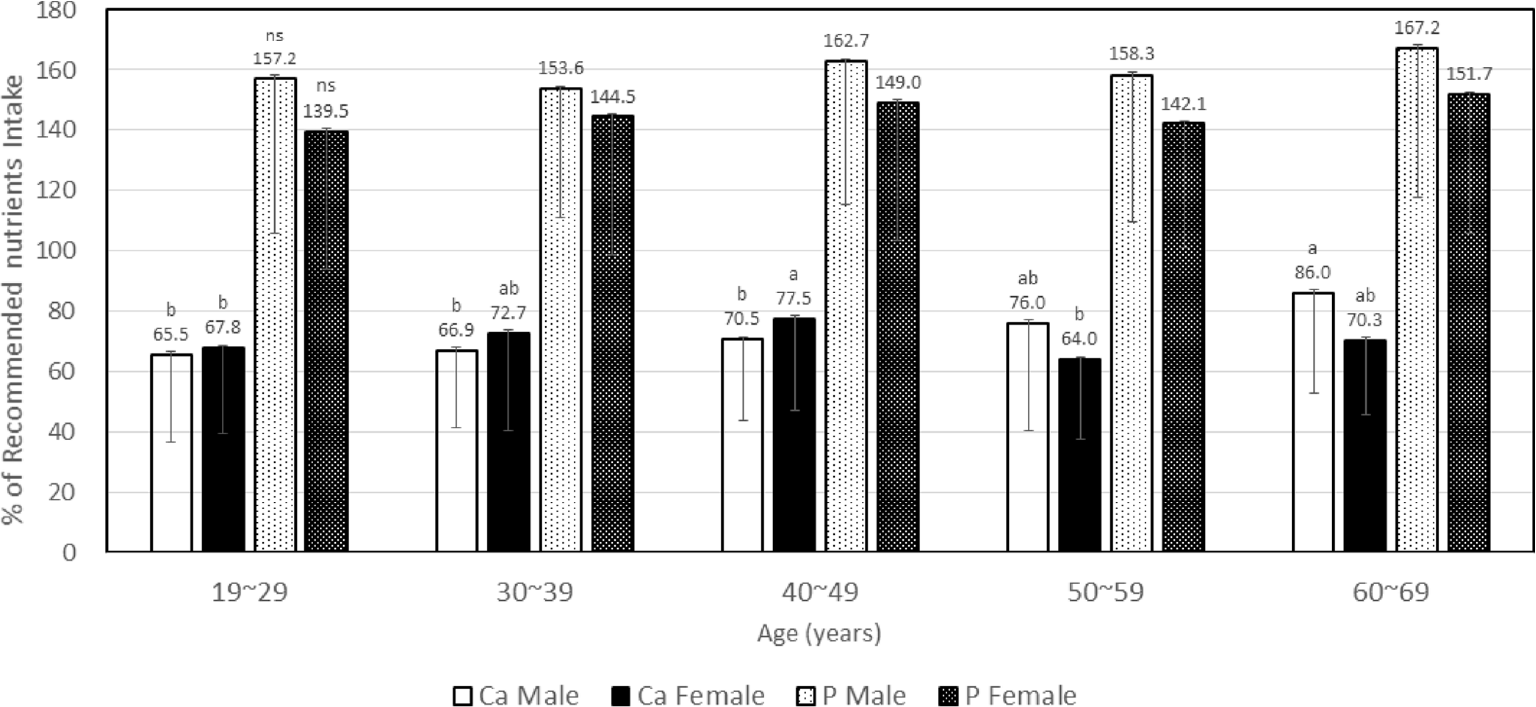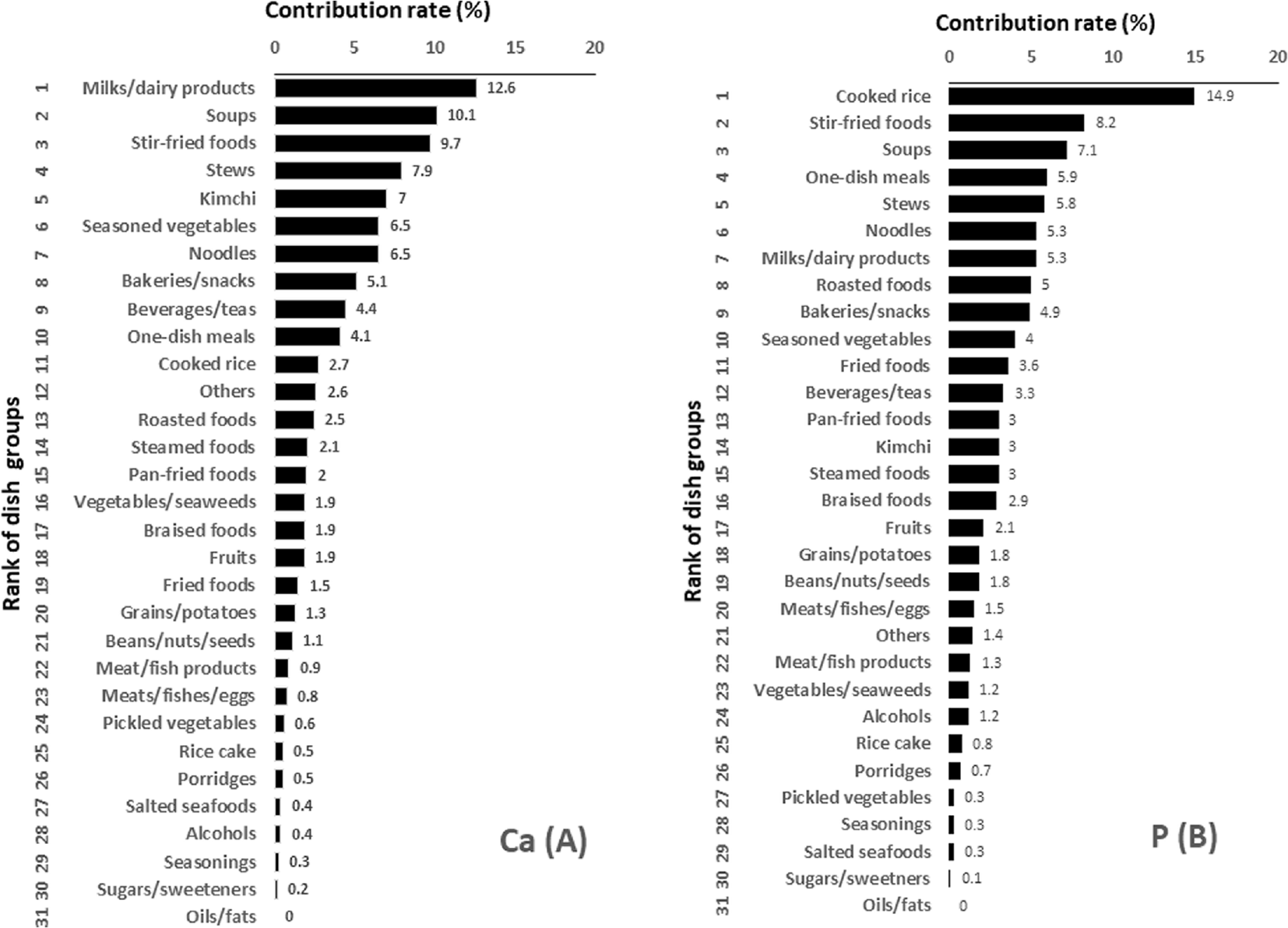Abstract
Objectives
Calcium (Ca) is an insufficiently consumed nutrient, whereas phosphorus (P) intake has exceeded the recommended intake level in Korea over the past decade. The purpose of this study was to analyze dietary Ca and P intakes and their contribution rate according to dish groups.
Methods
A 24-hour dietary recall survey of 640 healthy adults (aged 19–69 years) was undertaken twice in four Korean provinces. Dietary Ca and P intakes and their rates of contribution from 31 major dish groups were analyzed and compared by gender, age group, and region.
Results
The average Ca and P intakes of the subjects were 542.1 ± 222.2 mg/d and 1,068.3 ± 329.0 mg/d, respectively. The intakes of Ca and P as percentages of recommended nutrients intake (RNI%) were 71.7 ± 29.8% and 152.6 ± 47%, respectively, and the percentages under the estimated average requirement were 60.3% for Ca and 3.8% for P. The RNI% of Ca was not significantly different between males and females, but was significantly higher in subjects in the sixties age group than in other age groups and was significantly lower in the Korean capital than in other regions. The RNI% of P did not significantly differ by gender or age groups, but it was significantly higher in the capital than in Gyeong-sang. The five major dish groups contributing to Ca intake (contribution rate) were milks/dairy products 69.2 ± 109.2 mg/d (12.6%), soups 55.6 ± 69.6 mg/d (10.1%), stir-fried foods 53.1 ± 70.7 mg/d (9.7%), stews 43.4 ± 85.4 mg/d (7.9%), and kimchi 38.4 ± 31.8 mg/d (7.0%). The five major dish group contributing to P intake (contribution rate) were cooked rice 160.7 ± 107.1 mg/d (14.9%), stir-fried foods 88.5 ± 89.4 mg/d (8.2%), soups 76.7 ± 85.8 mg/d (7.1%), one-dish meals 63.3 ± 94.4 mg/ d (5.9%), and stews 62.6 ± 89.3 mg/d (5.8%). The dish groups contributing to Ca and P intakes differed somewhat by gender, age group, and region.
References
1. Cashman KD. Calcium intake, calcium bioavailability and bone health. Br J Nutr. 2002; 87(S2):S169–S177.

3. Matkovic V, Goel PK, Badenhop-Stevens NE, Landoll JD, Li B, Ilich JZ, et al. Calcium supplementation and bone mineral density in females from childhood to young adulthood: a randomized controlled trial. Am J Clin Nutr. 2005; 81(1):175–188.

4. Movassagh EZ, Vatanparast H. Current evidence on the association of dietary patterns and bone health: A scoping review. Adv Nutr. 2017; 8(1):1–16.

6. Lee YK, Hyun TS, Oh SY, Park HR, Ro HK, Heo YR, et al. Serum calcium is associated with dyslipidemia in a free-living Korean population: a cross sectional study. Trace Elem Electrolytes. 2017; 34(4):159–165.
7. Pannu PK, Calton EK, Soares MJ. Calcium and vitamin D in obesity and related chronic disease. Adv Food Nutr Res. 2016; 77:57–100.

8. Peterlik M, Cross HS. Vitamin D and calcium insufficiency-related chronic diseases: molecular and cellular pathophysiology. Eur J Clin Nutr. 2009; 63(12):1377–1386.

9. Chrysant SG, Chrysant GS. Controversy regarding the association of high calcium intake and increased risk for cardiovascular disease. J Clin Hypertens (Greenwich). 2014; 16(8):545–550.

10. Ministry of Health and Welfare, Korea Center for Disease Control and Prevention. Korea Health Statistics 2017: Korea National Health and Nutrition Examination Survey (KNHANES VII-2). Sejong: Ministry of Health and Welfare;2018.
11. Ministry of Health and Welfare, The Korean Nutrition Society. Dietary reference intake for Koreans 2015. Sejong: Ministry of Health and Welfare;2015. p. 570–637.
12. Calvo MS, Tucker KL. Is phosphorus intake that exceeds dietary requirements a risk factor in bone health? Ann NY Acad Sci. 2013; 1301(1):29–35.

13. Calvo MS, Uribarri J. Public health impact of dietary phosphorus excess on bone and cardiovascular health in the general population. Am J Clin Nutr. 2013; 98(1):6–15.

14. Ito S, Ishida H, Uenishi K, Murakami K, Sasaki S. The relationship between habitual dietary phosphorus and calcium intake, and bone mineral density in young Japanese women: a cross-sectional study. Asia Pac J Clin Nutr. 2011; 20(3):411–417.
15. Gutiérrez OM, Luzuriaga-McPherson A, Lin Y, Gilbert LC, Ha SW, Beck GR Jr. Impact of phosphorus-based food additives on bone and mineral metabolism. J Clin Endocrinol Metab. 2015; 100(11):4264–4271.

16. Lee AW, Cho SS. Association between phosphorus intake and bone health in the NHANES population. Nutr J. 2015; 14(2):28.

17. Choi YS. Development of research methods for determination of the dietary reference intakes for calcium. Cheongju: Korea Center for Disease Control and Prevention;2012.
18. Jeong HK, Kim JY, Lee HS, Kim JY. The effect of dietary calcium and phosphate levels on calcium and bone metabolism in rats. Korean J Nutr. 1997; 30(7):813–824.
19. Vorland CJ, Stremke ER, Moorthi RN, Hill Gallant KM. Effects of excessive dietary phosphorus intake on bone health. Curr Osteoporos Rep. 2017; 15(5):473–482.

20. Lee YK. Development of sodium adaptation index based on dietary habits of Korean. Cheongju: National Institute of Food and Drug Safety Evaluation;2016.
21. Ministry of Health and Welfare, Korea Center for Disease Control and Prevention. Korea Health Statistics 2012: Korea National Health and Nutrition Examination Survey (KNHANES V). Sejong: Ministry of Health and Welfare;2013.
22. Bristow SM, Gamble GD, Stewart A, Horne L, House ME, Aati O, et al. Acute and 3-month effects of microcrystalline hydroxyapatite, calcium citrate and calcium carbonate on serum calcium and markers of bone turnover: a randomised controlled trial in postmenopausal women. Br J Nutr. 2014; 112(10):1611–1620.

23. Lau EM, Woo J, Lam V, Hong A. Milk supplementation of the diet of postmenopausal Chinese women on a low calcium intake retards bone loss. J Bone Miner Res. 2001; 16(9):1704–1709.

24. Kim JY, Ahn BI. Effect of consumer's dietary lifestyle on consumption pattern of processed foods. Korean J Food Market Econ. 2015; 32(1):31–53.
25. Host A, McMahon AT, Walton K, Charlton K. Factors influencing food choice for independently living older people: A systematic literature review. J Nutr Gerontol Geriatr. 2016; 35(2):67–94.
26. Pechey R, Monsivais P. Socioeconomic inequalities in the healthiness of food choices: Exploring the contributions of food expenditures. Prev Med. 2016; 88:203–209.

27. Kim OY, Kwak SY, Kim B, Kim YS, Kim HY, Shin MJ. Selected food consumption mediates the association between education level and metabolic syndrome in Korean adults. Ann Nutr Metab. 2017; 70(2):122–131.

28. Shin BR, Choi YK, Kim HN, Song SW. High dietary calcium intake and a lack of dairy consumption are associated with metabolic syndrome in obese males: the Korean National Health and Nutrition Examination Survey 2010 to 2012. Nutr Res. 2016; 36(6):518–525.

29. Ministry of Health and Welfare, Office for Healthcare Policy. Korea Health Statistics 2015: Korea National Health and Nutrition Examination Survey (KNHANES VI-3). Sejong: Ministry of Health and Welfare;2016.
31. Takeda E, Yamamoto H, Yamanaka-Okumura H, Taketani Y. Increasing dietary phosphorus intake from food additives: potential for negative impact on bone health. Adv Nutr. 2014; 5(1):92–97.

32. Lou-Arnal LM, Arnaudas-Casanova L, Caverni-Muñoz A, Vercet-Tormo A, Caramelo-Gutiérrez R, Munguía-Navarro P, et al. Hidden sources of phosphorus: presence of phosphorus-containing additives in processed foods. Nefrologia. 2014; 34(4):498–506.
33. Shimada M, Shutto-Uchita Y, Yamabe H. Lack of awareness of dietary sources of phosphorus is a clinical concern. In Vivo. 2019; 33(1):11–16.

34. Korea Rural Economic Institute. The consumer behavior survey for food 2018. Naju: Korea Rural Economic Institute;2018.
Fig. 1.
Recommended nutrients intake (%) of Ca and P intake by gender and age groups The results were analyzed by ANOVA and bar with the different superscripts in age group within gender are significantly different by Duncan's multiple range test.

Fig. 2.
Contribution rate for Ca (left plot A) and P (right plot B) intake of the all subject by dish groups (n = 640)

Table 1.
Calcium and phosphorous intake of the subjects by gender, age and region
Table 1.
continued
Table 2.
Dietary calcium intake from major dish groups by gender, age and region
Table 2.
continued
Table 3.
Comparison of top 20 dishes contributing for dietary calcium intake by gender, age and region
Table 3.
continued
Table 4.
Dietary phosphorus intake from major dish groups by gender, age and region
Table 4.
Continued
Table 5.
Comparison of top 20 dishes contributing for dietary phosphorous intake by gender, age and region
Table 5.
Continued




 PDF
PDF ePub
ePub Citation
Citation Print
Print


 XML Download
XML Download